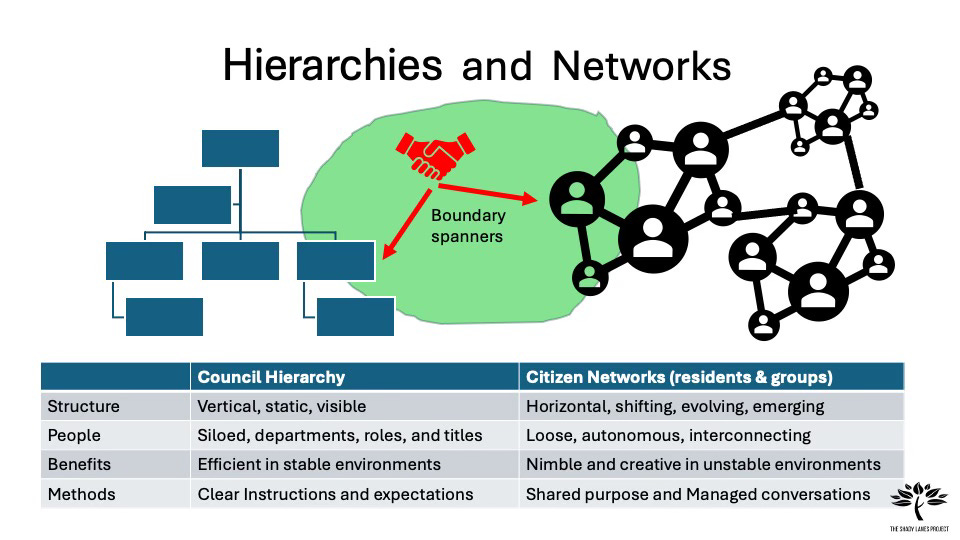Hierarchy or Network?
Reflecting on the structure of your group and the organisations that you are dealing with can make it easier to manage expectations and outcomes.
Verge garden projects are a rich source of learning for collaboration because they bring together two very different ways of operating: the hierarchical councils and the loose networks of residents.
Reflecting on the structure of your group and the various organisations that you are dealing with can make it easier to manage expectations and outcomes.
Which Are You?
This table shows the two extremes of hierarchical organisations and loose, interconnecting networks. Neither is good or bad, it’s a matter of what is most appropriate. We need both depending on what we are trying to do.
Any public service organisation like a council has to be a hierarchical, somewhat siloed, organisation to ensure efficiency, stability, and accountability. A Council run as a network would be chaos, you’d never get your bins emptied or anything else done.
On the other hand, individuals and groups need the freedom of a loose and evolving network structure to attract and empower people to create change in the community.
However, loose networks are not easy to manage and have much greater risks of cronyism, lack of diversity in thinking and membership, and the chaos of many people pulling in different directions.
is an example of a loose network where nobody can tell anyone else what to do. We manage the network by managing our conversations - civil, respectful, strategic - and by maintaining our shared purpose.To be successful in creating the cultural change and community participation needed for greening our streets, verge garden projects need to be managed in the same way.
Can Hierarchies and Networks Work Together?
Problems arise when there are no productive and respectful connections between the different types of organisations. In the verge gardening world, this is where you have the dramatic disputes between councils and residents that we see in the media.
It’s a world of distrust and accusations. Residents complain about bureaucratic councils, council officers don’t trust residents to garden sensibly with due consideration of all other users of the space.
We need boundary spanners between hierarchies and networks who can link the different ways of operating and form the good relationships, or chains of relationships, needed for innovative collaborations.
The diagram above shows the extremes - there can also be small networks and boundary-spanners within hierarchical organisations, and some community groups can be very hierarchical in nature.
The green area, where diverse people meet and form relationships, provides fertile ground for innovative collaborations for change. Boundary-spanners form relationships with people in different stuctures and disciplines to help build understanding of the differing worldviews and find creative solutions that benefit all participants. If you see boundary-spanners as mediators and these solutions as mere compromises, you’ll miss the energy and opportunities that can emerge from true collaborations.
Remember that council officers can be connected to community groups and networks through boundary-spanners in that green patch. Some of the most important work is done by those who work within hierarchical organisations and manage the complex and competing imperatives within their organisation with the demands of those outside.
If you are advocating for a verge garden policy with your council, this is the space you need to work in. You need to build trust and understanding between everyone involved. Adhering with the three guiding principles of the Shady Lanes Project will make this easier and get the most social and environmental benefit for all.
Doughnut Economics and Global Donut Days
I will be using this diagram in the Global Donut Days online session on 7th November 2024. It starts at 7:45am Brisbane time. Register to attend or get access to the recording of this and many other sessions from councils and communities around the world.
So, what is the structure and nature of your organisation? Are you a natural boundary-spanner? What qualities do you think it takes?
Please use the comments for questions and discussion.




Love your work Shady Lanes ❤️❤️❤️❤️